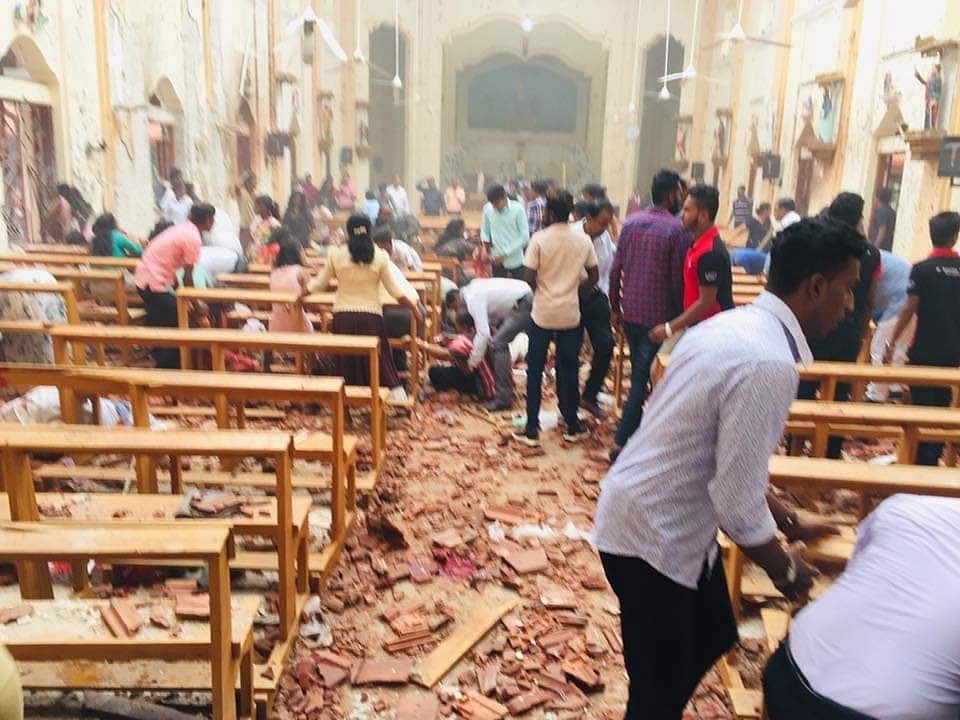Insta
Sri Lanka Confirms Islamist Terror Group National Thowheed Jamath Behind Easter Sunday Attack That Killed 290

Site of one of the blast (@aashiqchin/Twitter)
Sri Lanka has held local jihadist group National Thowheed Jamath responsible for the deadly terror attacks that killed at least 290 people on Easter Sunday (21 April) at churches and luxury hotels across the country.
Sri Lankan Cabinet spokesman Rajitha Senaratne said the bombings were carried out with the help of an international network.
Sri Lankan Police have so far arrested 24 suspects in connection with the country's worst attacks since the end of the catastrophic civil war in 2009.
The Government also admitted said it had been warned at least three times in recent weeks that a possible terror attack during the holy holiday was imminent. One of the alerts reportedly came 10 minutes before the massacre, which the government has said was carried out by suicide bombers.
National Thowheed Jamath shot into prominence mainly in Sri Lanka for vandalising Buddhist statues. In 2016, its secretary, Abdul Razik, was arrested on charges of inciting racism.
The Wahhabi-aligned ground has found resonance in the eastern province and has been advocating Sharia law with mandatory burqas for women and building mosques to disseminate radical messages.
According to Rohan Gunaratna, a Professor of Security Studies Head of International Centre for Political Violence and Terrorism Research at the S. Rajaratnam School Of International Studies, the March 2018 Sinhala-Muslim riots in Sri Lanka was a clear pointer to growing communal schisms between Buddhist majority and Muslims in the island state.
In a paper titled “Sinhala-Muslim Riots in Sri Lanka: The Need for Restoring Communal History”, Prof. Gunaratna wrote that:
The Sinhala-Muslim riots in Sri Lanka in March 2018 erupted following a traffic accident in which four Muslim youth attacked a Sinhala driver in Kandy on 22 February 2018. The driver was seriously injured and died in hospital in Kandy on 3 March 2018.
The police detained 14 suspects, including the four youth who attacked the driver. Overall, the violence that ensued killed two people, injured 15 others, and damaged 45 businesses, homes, and four places of religious worship.
Following the communal unrest, a ten-day emergency was imposed and the military was deployed in aid of police. Kandy’s Digana and Teldeniya areas were the main hotspots of violence until the police and military restored normalcy.
Sinhalese resentment against Muslims has been growing slowly. Despite the fact that the Sinhalese are a majority in Sri Lanka, they suffer from a minority complex because the population growth of the Muslims surpasses that of the Sinhalese. The population growth of the Buddhist community stands at 1.1 per cent since 1948 whereas the population growth of Muslims is 1.9 per cent.
The Muslim landscape in Sri Lanka has been changing since the last decade. Muslims constitute about 9.7 per cent of Sri Lanka’s population. Buddhists form 70 per cent of the population. Meanwhile, 12 per cent are Hindus and 7 per cent are Christians.
Before the recent riots in the Sinhala majority areas of Western and Central Provinces, the Muslims residing in the Tamil-dominated northern and eastern areas had been attacked by Tamil separatists.
The Liberation Tigers of Tamil Eelam (LTTE), an erstwhile ethno-separatist group fighting to create an independent Tamil state, had subjected the Muslims and Sinhalese to ethnic cleansing. For instance, in August 1990, the LTTE killed 147 Muslims in mosques in Kattankudy.
The Muslims did not withdraw from the east, but worked with the Sri Lankan security forces to fight back against terrorism. Muslims also served in the units of the Sri Lankan security forces. The end of the conflict after LTTE’s defeat in 2009 created space for Muslims and Sinhalese to reassert themselves.
The Muslim community underwent some changes as indigenous Islamic practices were slowly being influenced by practices from parts of the Middle East.
The growing influence of Salafism and Wahabbism had led Sinhalese hardliners to develop suspicions and prejudices against the local Muslim community.
They attributed developments such as the three dozen Muslims who travelled to Iraq and Syria to join the so-called ‘Islamic State’ (IS), the emergence of Jamaat Tawheed and demand for halal certification, to foreign influences. In addition, Muslims in Sri Lanka were perceived to be increasingly leaning towards exclusivism.
Support Swarajya's 50 Ground Reports Project & Sponsor A Story
Every general election Swarajya does a 50 ground reports project.
Aimed only at serious readers and those who appreciate the nuances of political undercurrents, the project provides a sense of India's electoral landscape. As you know, these reports are produced after considerable investment of travel, time and effort on the ground.
This time too we've kicked off the project in style and have covered over 30 constituencies already. If you're someone who appreciates such work and have enjoyed our coverage please consider sponsoring a ground report for just Rs 2999 to Rs 19,999 - it goes a long way in helping us produce more quality reportage.
You can also back this project by becoming a subscriber for as little as Rs 999 - so do click on this links and choose a plan that suits you and back us.
Click below to contribute.
Latest